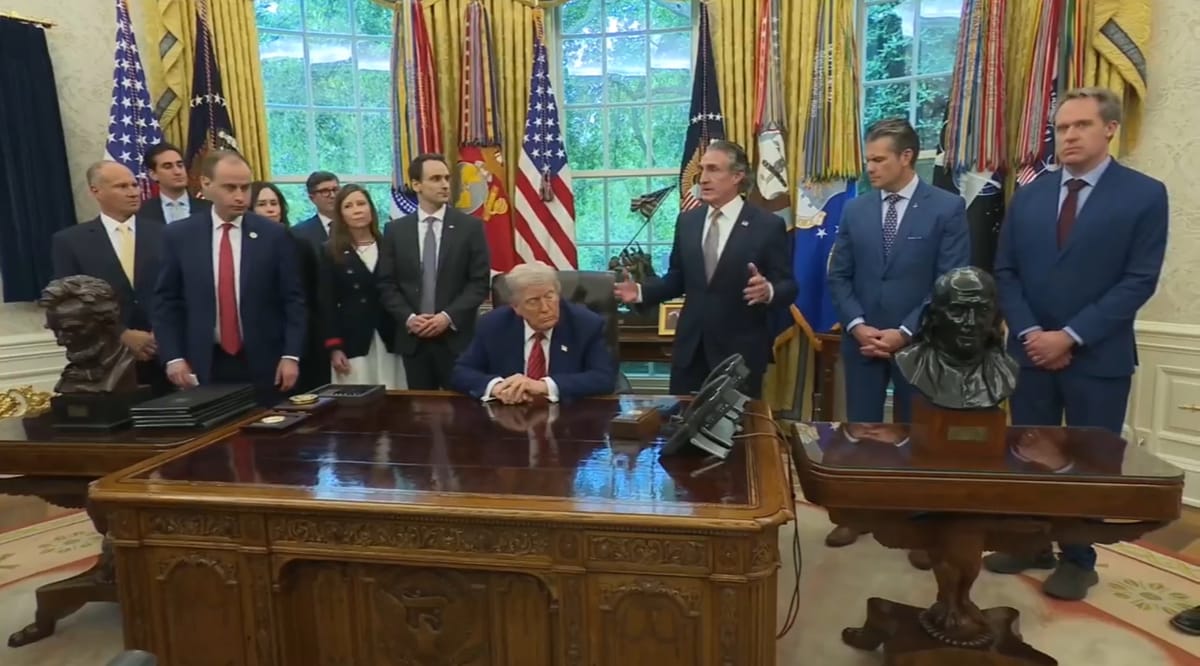President Trump Signs Executive Orders to Revitalize U.S. Nuclear Industry
Three EOs will revitalize America’s nuclear industry, enhance competitiveness with China

Declaring “It’s time for nuclear,” President Donald Trump signed a series of Executive Orders (EOs) on Friday, May 23 to revitalize the United States' nuclear energy sector. These measures will accelerate the development and deployment of advanced nuclear technologies, streamline regulatory processes, and bolster national security infrastructure.
The first EO, ORDERING THE REFORM OF THE NUCLEAR REGULATORY COMMISSION mandates a comprehensive reform of the Nuclear Regulatory Commission (NRC). Key provisions include:
- Establishing fixed deadlines for license evaluations, with an 18-month deadline for new reactor construction and operation approvals, and a 12-month deadline for continued operation of existing reactors.
- Revising regulations and guidance documents to balance safety concerns with the economic and national security benefits of nuclear energy.
These reforms are intended to reduce regulatory barriers and support the domestic nuclear industry.
The second EO, REFORMING NUCLEAR REACTOR TESTING AT THE DEPARTMENT OF ENERGY, directs the Department of Energy (DOE) to fast-track the testing and deployment of advanced nuclear reactors. Citing decades of stalled innovation and regulatory barriers, the order seeks to reignite reactor development that could power industries ranging from data centers to hydrogen production. Key actions include:
- A new framework for defining and approving "qualified test reactors" capable of becoming operational within two years.
- Mandated regulatory reforms at the DOE and national laboratories to expedite reactor reviews and approvals.
- A pilot program to construct at least three advanced reactors outside national labs, with a goal of achieving criticality by July 4, 2026.
- Streamlined environmental reviews under the National Environmental Policy Act (NEPA), including broader use of categorical exclusions and accelerated permitting.
- Coordination with White House offices and the Council on Environmental Quality to implement these reforms.
The order prioritizes microreactors, small modular reactors, and other Generation III+ and IV technologies, positioning nuclear energy as essential to national security and economic competitiveness. These actions are designed to enhance energy resilience for critical defense and AI infrastructure and spur a “nuclear energy renaissance.”
The third EO, REINVIGORATING THE NUCLEAR INDUSTRIAL BASE, invokes the Defense Production Act to partner with private industry and stabilize critical fuel supplies, aligning with a broader national strategy to ensure energy independence and compete globally—particularly with China’s rapid nuclear expansion. Key measures include:
- A goal of 10 new reactors under construction by 2030 and 5 gigawatts in power uprates at existing plants.
- New plans to reprocess and recycle nuclear fuel, and halt the "dilute and dispose" program for surplus plutonium.
- A mandate to rebuild domestic uranium enrichment and conversion capacity for civilian and defense needs.
- Support for small businesses developing advanced nuclear technologies.
- Workforce development through expanded apprenticeships and educational grants in nuclear fields.
This order addresses the surging electricity demand from data centers and AI technologies by accelerating nuclear energy development.
These EOs are, in part, a response to China’s growing dominance in the nuclear energy sector. China's rapid expansion of its nuclear energy capacity has significant implications for global energy competition. As of the end of 2024, China had 102 nuclear reactors in operation, under construction, or approved for construction, with a combined installed capacity of 113 million kilowatts, surpassing other nations in overall nuclear power capacity. This growth is part of China's broader strategy to achieve carbon neutrality by 2060 and reduce reliance on coal. The country's commitment to nuclear energy is evident in its consistent approval of new reactors, with at least 10 new units approved annually for four consecutive years. These developments not only enhance China's energy security but also bolster its geopolitical influence, as it seeks to export nuclear technology to other countries.
Alabama Senator Tommy Tuberville responded to Friday’s EOs on Facebook, saying, “GREAT news for energy independence. Alabama is proud to be home to 2 nuclear plants and 5 nuclear reactors, and we MUST continue to invest in nuclear energy as we unleash America’s energy production.”
The nuclear industry responded positively to the Executive Orders. Stocks of nuclear-related companies, such as Constellation Energy Corp. and Vistra Corp., saw increases following the announcement. The Global X Uranium ETF rose by 12%, reflecting investor optimism about the sector's revitalization.
While the administration emphasizes the need for energy independence and technological advancement, some experts express caution. Concerns include the feasibility of quadrupling nuclear output within 25 years and the potential risks associated with weakening the NRC's independence. Environmental groups also highlight issues related to radioactive waste management and safety oversight.
The White House Fact Sheet on the three EOs is HERE. Today’s signing ceremony is available for viewing on YouTube:




